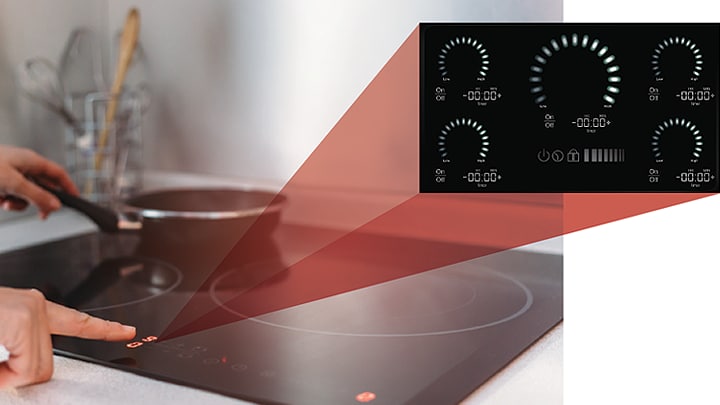KE1xZ robust 5V MCUs put capacitive touch sensing technology at your fingertips.
Touchscreens are so commonplace in our smart, connected world that it's hard to imagine daily life
without the intuitive ease and convenience of touch sensing interfaces. Think about all of the
devices we control with a simple touch, pinch or swipe: kitchen appliances, refrigerators,
thermostats, smartphones, laptops, tablets and other handheld devices, game consoles, automotive
infotainment displays, smart home and building controls, point-of-sale terminals, electronic
voting machines and a wide range of industrial controls. The list is virtually endless.
The phenomenal popularity of touch-enabled smartphones fueled the rapid growth of the touchscreen
market. Capacitive touch technology quickly eclipsed resistive controls, and capacitive is now the
dominant touch technology in the smartphone, handheld and consumer electronics markets. And for
good reason: resistive touchscreens are notoriously inaccurate, hard to use and often limited to
one touch at a time while capacitive touch is much more precise, more affordable and easier to
implement, and can support advanced multi-touch and pinch-to-zoom control.
Human machine interface (HMI) is an interactive screen that provides information, data and
situation metrics of a system to a human operator. HMI innovation never rests, and now we have
advanced gesture and voice controls and even combinations of both technologies, enabling
sophisticated touchless user interfaces – a boon for new and emerging products during the
touch-adverse COVID-19 pandemic.
Despite the growing popularity of touchless controls among tech enthusiasts, the tried-and-true
touchscreen is still one of the easiest to use, most intuitive of all interfaces. Touch sensing
remains a proven, go-to HMI technology for myriad applications, making clunky, unreliable
electromechanical pushbutton controls a thing of the past. Nowadays, it’s simply touch and go.
NXP Kinetis E Series MCUs: In Touch with the Times
With the constant demand for capacitive touch controls in embedded applications, developers are
continually seeking faster, easier and more economical ways to add capacitive sense interfaces to
their products. NXP has been providing capacitive touch sensing solutions for several years,
offering a wide range of 8-bit and 32-bit touch-enabled microcontrollers (MCUs), along with a
comprehensive hardware and software ecosystem to simplify touch interface application development.
NXP continues to develop touch sense interface (TSI) technology to address new consumer and
industrial use cases and demanding application requirements.
NXP has expanded its 32-bit Kinetis E family, part of the EdgeVerse™
edge computing
platform, to include the
KE1xZ series of
robust 5V MCUs offering high performance, broad scalability and advanced touch sensing
capabilities. Based on the Arm® Cortex®-M0+ core running at up to 72 MHz, the KE17Z/13Z/12Z MCUs
support up to 256 KB flash, 48 KB RAM, and a rich set of analog/digital peripherals. The KE1xZ
series extends the Kinetis E family with optional dual-touch TSI technology supporting up to 50
channels, providing a high level of stability and accuracy for HMI applications.
NXP’s KE1xZ touch sensing MCUs provide turnkey solutions for adding sleek, intuitive, touch-based
user interfaces to a wide range of products including home appliances, consumer electronics,
lighting control, portable devices, medical equipment, point-of-sale equipment, 5V motor control,
and industrial instrument and control panels. The KE1xZ MCUs offer advanced noise immunity,
water-tolerant touch and low-power wake-on-touch operation, essential features for the strict
electromagnetic compatibility (EMC) standards of the industrial and home appliance markets.
The 5V KE1xZ MCUs are designed to maintain high reliability and robustness in operating
environments subject to harsh electrical noise, making them a good choice for home appliances,
industrial and automotive designs. The KE1xZ MCUs include a 12-bit ADC, capable of up to 1
mega-sample per second (Msps), and up to three FlexTimers, making the MCUs an ideal solution for
brushless DC (BLDC) motor control systems. Optional MSCAN technology, a communication controller
specification implementing the CAN 2.0A/B protocol, allows the MCUs to be used for CAN node
control and automotive aftermarket applications.
Cooking with NXP Touch Technology
Today’s multi-burner induction cooktops exemplify an application challenge where NXP’s robust
KE1xZ MCUs and versatile touch control technology really shine.
It begins with the KE17Z MCU’s dual TSI technology supporting up to 50 touch channels. In the
self-capacitive mode, developers can use these 50 channels to design 50 (25 x 2) touch pads. In
the mutual-capacitive mode, design options expand to up to 72 (6 x 6 x 2) pads. In some use cases
such as a multi-burner induction cooker with touch controls, the MCUs can support touchscreen
designs scaling up to 98 pads (26 pads using self-capacitance + 72 pads using mutual channels).
These flexible multi-touch design capabilities enable consumers to easily control multiple
induction burners, accurately adjust the heat and cook large family meals on a single induction
stovetop.
 Induction Stovetop with Touch Panel
Induction Stovetop with Touch Panel
The KE1xZ MCUs also include three shield channels in each TSI module to enhance liquid tolerance
in the presence of water, steam, oil and other spills. NXP’s configurable TSI technology supports
adjustable resolution and sensitivity allowing it to perform in challenging environments, even
when implemented beneath 12 mm glass or 10 mm glass/plastic overlays, or in industrial control
systems requiring high tolerance of harsh conditions.
Comprehensive Enablement Solutions for Touchscreen Applications
NXP’s comprehensive hardware and software ecosystem enables developers to quickly evaluate,
prototype and create innovative capacitive touch sensing applications. NXP’s Freedom development
platforms include low-cost, compatible boards with a rich set of third-party expansion options.
NXP’s
MCUXpresso software development kit
(SDK) also includes a library of touch sense software.
To help developers jumpstart their designs, NXP offers a series of application notes including a
BLDC use case, 2D touch solutions, hardware design guideline and software migration guidelines
for the FRDM-KE17Z evaluation board, FRDM-TOUCH development platform and
FRDM-MC-LVBLDC
3-phase BLDC motor control development platform.
NXP also provides the
X-KE17Z-TSI-EVB touch-pattern evaluation board to help developers evaluate and prototype self-capacitive touch keys, mutual cap touchpads,
digital touch sliders, proximity loops and shield electrodes.
Learn more about the
KE1xZ series of MCUs
and how to design your next capacitive touch interface application.






